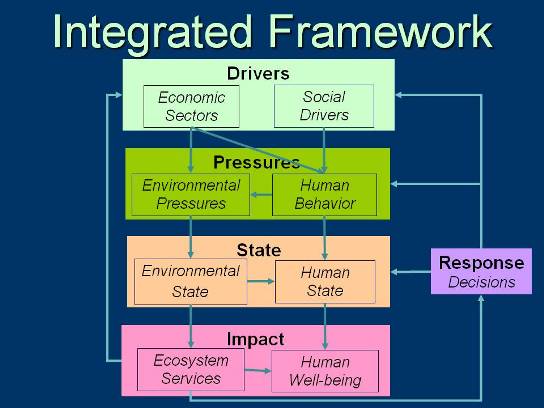Tutorials on Systems Thinking
Integrated Framework: Response

9 / 26
Responses are actions taken by groups or individuals in society and government to prevent, compensate, ameliorate or adapt to changes in well-being due to the state of the environment or condition of human health. Decisions that benefit one economic sector may lead to environmental degradation that weakens another economic sector. For example, Impacts on ecosystems services and human well-being will affect the quality and quantity of natural capital and human capital available to economic sectors. By linking Impacts back to socio-economic Drivers (left, upward arrow), tradeoffs in the system can be identified.
- Driver-level Responses - attempt to modify economic sectors by increasing the number of available options or alternatives to fulfill a given need, and may includes energy policies, health policies, transportation policies, construction policies, tourism & recreation policies, educational reforms, or technological innovations. Also includes responses to modify social drivers, such as through environmental justice policies or decision support.
- Pressure-level Responses - attempt to control the ongoing activities of socio-economic drivers that place pressure on the environment; Includes Land-use management through permitting, city planning, or zoning, Discharge limitations through regulations or technological improvements, and Resource-use Management through harvesting regulations or protected areas, or agricultural best management practices; may also attempt to modify human behavior through outreach and education.
- State-level Responses - directly attempt to restore, modify, or maintain the condition of the environment through Monitoring, remediation, & restoration or setting water quality or air quality standards. Responses may also attempt to modify the built environment through technological improvements, such as removal of hazardous factors. Responses may also attempt to directly modify human condition through medical treatments or community planning to identify or ameliorate disparities.
- Impact-level Responses - attempt to quantify or modify ecosystem services through valuation, monitoring, subsidies, or mitigation, and to quantify human well-being through index development or monitoring.
